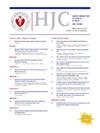经桡动脉远端入路和传统经桡动脉入路经皮冠状动脉介入治疗急性冠状动脉综合征的长期预后比较
IF 3
3区 医学
Q2 CARDIAC & CARDIOVASCULAR SYSTEMS
引用次数: 0
摘要
背景:经桡动脉远端入路(dTRA)最近已成为冠状动脉造影(CAG)和/或经皮冠状动脉介入治疗(PCI)的一种新的血管入路选择。然而,关于经桡动脉远端入路进行 PCI 后的长期死亡率和主要心脏不良事件的公开数据尚无定论。本研究旨在比较经 dTRA 和传统经桡动脉入路(cTRA)PCI 治疗急性冠状动脉综合征(ACS)1-3 年后的长期预后:方法:回顾性纳入 2020 年 1 月 1 日至 2021 年 12 月 31 日期间确诊为 ACS 并接受 PCI 治疗的患者。按照 1:1 的比例将患者分为两组,进行倾向评分匹配(PSM),然后在 PCI 后随访 1-3 年。Cox比例危险回归用于评估两个入路部位与临床结果之间的关系:dTRA组和cTRA组的550名患者中,分别有11人(4.0%)和19人(6.9%)在观察期内死亡。PCI后,dTRA组和cTRA组的全因死亡率[危险比(HR)=0.688;95% CI=0.323-1.463;P=0.331]和主要心脏不良事件(MACEs,HR=0.806,95% CI=0.515-1.263;P=0.347)风险相似。两组患者的心血管死亡风险(HR=0.330,95% CI=0.107-1.105;P=0.053)、TLR-MACEs(HR=0.587,95% CI=0.339-1.109;P=0.058)和计划外血管重建风险(HR=0.860,95% CI=0.483-1.529;P=0.606)无显著差异:结论:在ACS患者中,通过dTRA进行PCI与通过cTRA进行PCI具有相同的长期预后,而且压缩时间和出血率低于通过cTRA进行PCI的患者。本文章由计算机程序翻译,如有差异,请以英文原文为准。

Comparison of long-term prognoses of percutaneous coronary intervention via distal transradial and conventional transradial access for acute coronary syndrome
Background
Distal transradial access (dTRA) has recently emerged as a new vascular access alternative for coronary angiography (CAG) and/or percutaneous coronary intervention (PCI). However, published data on long-term mortality and major adverse cardiac events after PCI via dTRA are inconclusive. The aim of this study was to compare the long-term prognoses of PCI via dTRA and conventional transradial access (cTRA) for acute coronary syndrome (ACS) after 1–3 years of follow-up.
Methods
Patients who were diagnosed with ACS and underwent PCI between January 1, 2020 and December 31, 2021, were retrospectively enrolled. The patients were divided into two groups at a 1:1 ratio, subjected to propensity score matching (PSM), and then followed for 1–3 years after PCI. Cox proportional hazards regression was used to evaluate the relationship between the two access sites and clinical outcomes.
Results
Among the 550 patients in the dTRA and cTRA groups, 11 (4.0%) and 19 (6.9%) died during the observation period, respectively. dTRA and cTRA had similar risks of all-cause mortality [hazard ratio (HR) = 0.688; 95% CI = 0.323–1.463; P = 0.331] and major adverse cardiac events (MACEs, HR = 0.806, 95% CI = 0.515–1.263; P = 0.347) after PCI. The risk of cardiovascular mortality (HR = 0.330, 95% CI = 0.107–1.105; P = 0.053), TLR-MACEs (HR = 0.587, 95% CI = 0.339–1.109; P = 0.058), and unplanned revascularization (HR = 0.860, 95% CI = 0.483–1.529; P = 0.606) were not significantly different between the two groups.
Conclusions
PCI via dTRA has the same long-term prognoses as PCI via cTRA in ACS patients, and the compression time and bleeding rate are lower than those in patients undergoing PCI via cTRA.
求助全文
通过发布文献求助,成功后即可免费获取论文全文。
去求助
来源期刊

Hellenic Journal of Cardiology
CARDIAC & CARDIOVASCULAR SYSTEMS-
CiteScore
4.90
自引率
7.30%
发文量
86
审稿时长
56 days
期刊介绍:
The Hellenic Journal of Cardiology (International Edition, ISSN 1109-9666) is the official journal of the Hellenic Society of Cardiology and aims to publish high-quality articles on all aspects of cardiovascular medicine. A primary goal is to publish in each issue a number of original articles related to clinical and basic research. Many of these will be accompanied by invited editorial comments.
Hot topics, such as molecular cardiology, and innovative cardiac imaging and electrophysiological mapping techniques, will appear frequently in the journal in the form of invited expert articles or special reports. The Editorial Committee also attaches great importance to subjects related to continuing medical education, the implementation of guidelines and cost effectiveness in cardiology.
 求助内容:
求助内容: 应助结果提醒方式:
应助结果提醒方式:


